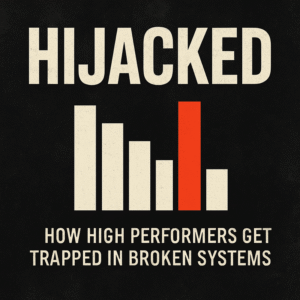How High Performers Get Trapped in Broken Systems
This is for the mission-critical personnel, back-end leaders, internal advisors, structural stabilizers—the quiet professionals who keep systems from breaking. These are the folks who quietly perform and rarely get recognized. It’s a topic quietly discussed across teams in many organizations—but rarely addressed directly. Maybe that’s because of overused phrases like “extreme ownership” or other systems meant to improve work cultures.
“Extreme ownership” is not really up for debate—you should hold yourself to higher standards and be accountable for your actions and omissions. Not everyone does. But you should. You should build resilience. But there’s a difference between owning outcomes and being set up to absorb everyone else’s failure. In some organizations, power protects itself by offloading dysfunction onto high performers who work steadily, value discretion, and say little. Their mindset isn’t about organizational politics—it’s about performance and results. They solve problems. And over time, that makes them indispensable—and invisible.
Invisible work is the curse of the competent. In dysfunctional organizations, it’s the reliable operators who end up shouldering the work no one sees and few appreciate. The more capable they are, the more others offload. Over time, competence gets mistaken for capacity, and silence becomes the standard reward.
Studies in Harvard Business Review and MIT Sloan have consistently found that the most competent team members are disproportionately tasked with invisible or unrewarded work—like crisis management, emotional labor, and gap-filling. In environments lacking accountability and clear structure, this becomes a systemic issue.
These organizations suffer from a fatal imbalance: responsibility without power. Decision-making is consolidated at the top, not based on merit but on hierarchy, tenure, or internal loyalty. Influence circulates among a closed circle, while capable operators are left executing under ambiguity. They’re expected to stabilize dysfunction without ever threatening it.
As organizational research has shown, many systems transfer responsibility to competent individuals without granting the authority required to act on it.
This creates a form of professional hijacking. High-functioning individuals are drawn in to fix what’s broken—but only to the extent that their competence doesn’t threaten anyone’s position. Their reliability becomes their liability. The more they hold everything together, the more invisible they become. In some contexts, that difference means life or death—for teammates, civilians, or the public they serve.
This isn’t just true in combat or law enforcement—it’s true in aviation, energy, manufacturing, and even hospitals. Anywhere reliability is assumed but never reinforced, quiet professionals are left to absorb the shock.
Unlike high-trust cultures where ownership and credit are shared, these workplaces depend on appearances and control. Looks matter more than results. People addressing real issues are kept behind the scenes, while surface-level performers are promoted for maintaining consensus. If you consistently outperform, you’re often seen as either a threat or a tool—rarely as a leader.
And these organizations seldom evolve. The same personalities and behaviors that create the dysfunction are rewarded and reinforced over time. Legacy mindsets dominate. Rituals replace results. When institutional memory fades, what’s left is often an empty process masquerading as strategy.
Eventually, these systems collapse—or get hollowed out from within. The operators who once held the business together burn out or walk away. Leadership either doesn’t notice until it’s too late, or worse, notices and still lets it happen. The short-term logic of survival overwhelms any long-term vision.
And when those operators finally leave, the illusion breaks. What appeared to be a high-functioning organization was often just a fragile machine propped up by a few overextended individuals.
“The quiet professional is honored in doctrine—but overlooked in practice. This is the cost of misplacing power—and mistaking silence for stability.”

